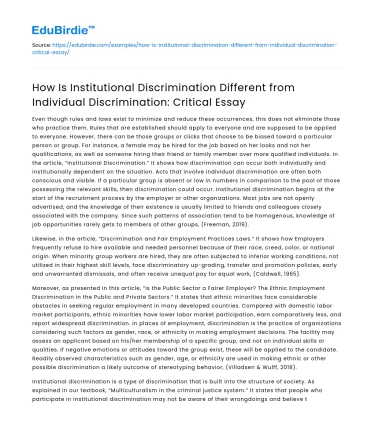Even though rules and laws exist to minimize and reduce these occurrences, this does not eliminate those who practice them. Rules that are established should apply to everyone and are supposed to be applied to everyone. However, there can be those groups or clicks that choose to be biased toward a particular person or group. For instance, a female may be hired for the job based on her looks and not her qualifications, as well as someone hiring their friend or family member over more qualified individuals. In the article, “Institutional Discrimination.” It shows how discrimination can occur both individually and institutionally dependent on the situation. Acts that involve individual discrimination are often both conscious and visible. If a particular group is absent or low in numbers in comparison to the pool of those possessing the relevant skills, then discrimination could occur. Institutional discrimination begins at the start of the recruitment process by the employer or other organizations. Most jobs are not openly advertised, and the knowledge of their existence is usually limited to friends and colleagues closely associated with the company. Since such patterns of association tend to be homogenous, knowledge of job opportunities rarely gets to members of other groups, (Freeman, 2019).
Likewise, in the article, “Discrimination and Fair Employment Practices Laws.” It shows how Employers frequently refuse to hire available and needed personnel because of their race, creed, color, or national origin. When minority group workers are hired, they are often subjected to inferior working conditions, not utilized in their highest skill levels, face discriminatory up-grading, transfer and promotion policies, early and unwarranted dismissals, and often receive unequal pay for equal work, (Caldwell, 1965).
Moreover, as presented in this article, “Is the Public Sector a Fairer Employer? The Ethnic Employment Discrimination in the Public and Private Sectors.” It states that ethnic minorities face considerable obstacles in seeking regular employment in many developed countries. Compared with domestic labor market participants, ethnic minorities have lower labor market participation, earn comparatively less, and report widespread discrimination. In places of employment, discrimination is the practice of organizations considering such factors as gender, race, or ethnicity in making employment decisions. The facility may assess an applicant based on his/her membership of a specific group, and not on individual skills or qualities. If negative emotions or attitudes toward the group exist, these will be applied to the candidate. Readily observed characteristics such as gender, age, or ethnicity are used in making ethnic or other possible discrimination a likely outcome of stereotyping behavior, (Villadsen & Wulff, 2018).
Institutional discrimination is a type of discrimination that is built into the structure of society. As explained in our textbook, “Multiculturalism in the criminal justice system.” It states that people who participate in institutional discrimination may not be aware of their wrongdoings and believe they are treating others in fairness. Even though people may be subjected to the same treatment, some traits can limit and discriminate against a group based on their physique. For instance, the example used within our textbook speaks about certain height and weight requirements for police officers or firefighters. However, it was learned that these requirements were not associated with the actual ability to perform these duties. Therefore, these requirements were later abolished in favor of better equality of testing and requirements, (McNamara & Burns, 2009).
There can be forms of blatant discrimination and others that may go unnoticed. For instance, a church organization may ban someone such as same-sex couples from attending church functions because of their beliefs. A more critical account of these types of situations is when the cake maker of a local business refused to bake a wedding cake for a couple, who were intending on having a same-sex marriage. Likewise, as mentioned in the previous question, some places of employment encourage females and minority groups to apply to any other applicant. Moreover, some of these locations have even offered recruitment bonuses for these groups, but not for any other group, in order to hire more of the certain targeted groups.
Also, over the last few years, Congress has issued a purge of military personnel in order to lower the workforce within the Department of Defense. Many personnel was released from their contract for various reasons. One member, who had served thirteen years in the National Guard, had been classified as overweight by their current standards and was released from service. Another example is certain places only hire applicants that have a college degree. The work does not require a college education, but to be considered for the job, a person will need to have some form of education from a college institution. Therefore, there can be different reasons and different forms of discrimination that may limit someone from performing their job or being offered a place of employment, in which they are qualified.






 Stuck on your essay?
Stuck on your essay?

